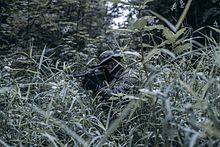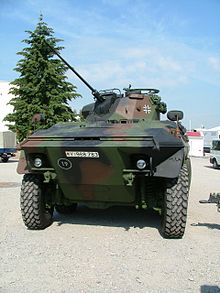Reconnaissance
The Spähaufklärung ( SpähAufkl , English scout reconnaissance ) is the elucidation of enemy forces and means ground-based, by eye observation, often with technical assistance rendered and if necessary enforced by battle. It is carried out by special reconnaissance units such as the tank reconnaissance troops and the long-distance reconnaissance troops or today's army reconnaissance troops and the special forces . The reconnaissance serves to provide information on a tactical and operational level from the large formation ( brigade and up).
aims
The information from the reconnaissance serves the basis and decision-making for the respective battle planning. You should u. a. protect against a surprise attack by the enemy. In addition, reconnaissance should secure before being surrounded in flanks or in unoccupied rooms. In contrast to the combat reconnaissance, the reconnaissance serves the large association. Similar to combat reconnaissance, information on enemy strength, battle structure and behavior should also be obtained here. Furthermore, knowledge of the position of his heavy weapons (artillery and mortars), command facilities and command posts, followers, reserves, supply points, etc. In some cases, ABC reconnaissance is also part of the range of tasks. These reconnaissance results are reported back to the brigade or division with a certain veil over far-reaching telecommunication means.
execution
In the attack type of operation , the reconnaissance begins with a certain amount of time in advance at a certain depth of clarification. The reconnaissance is therefore usually the first act of an army formation. A division has an area of responsibility of around 75 kilometers, in which reconnaissance results must be obtained. This means that scouting teams are generally required to penetrate around 80 km. The corps can use tele-scouting trains here, but they can also reach a maximum penetration depth of 200 km. Brigades are assigned a combat patrol of around 25 to 30 km. The brigade patrol trains are deployed in this room . This is followed by the battle reconnaissance and only when the information obtained from it has been processed, the actual attack. Scouting troops deployed by the brigade or division do not perform the tasks of site exploration (such as their own disposal rooms, command posts, etc.). This is reserved for the reconnaissance and liaison platoons of the battalions' respective staff and supply companies . Ground-based reconnaissance also includes battlefield radar reconnaissance. This is where the PARA system (tank reconnaissance radar) comes into play, which is able to detect vehicles at a distance of up to 20 kilometers and people up to eight kilometers. These radars mostly have a short range and are specialized for certain tasks. Radar squads are used independently or in conjunction with other branches of arms . The situation in the combat of combined arms or the deployment in enemy-occupied territory may require the deployment of reinforced reconnaissance troops (cooperation with army pilots, tanks, tank grenadiers , engineers or joint fire support teams of artillery and mortars). If possible, reconnaissance forces should not be worn out, i. H. in combat operations, as they must continue their reconnaissance mission in any case.
In each of the types of operation, reconnaissance is carried out at a certain depth of reconnaissance. The reconnaissance is therefore usually the first act of an army formation. A division has an area of responsibility of around 75 kilometers, in which reconnaissance results must be obtained. This means that scouting teams are generally required to penetrate around 80 km. Remote observation troops are deployed by the Großverband Korps, which have a maximum penetration depth of 200 km. Brigades are assigned a combat strip of around 25 to 30 km. The brigade patrol trains are deployed in this room . Combat reconnaissance is carried out by reinforced patrols in order to gain reconnaissance results with combat. The reconnaissance team then consists of reconnaissance vehicles and battle and armored personnel carriers. Scouting parties rarely have the task of exploring the terrain. The exploration of your own area of disposal or command posts is carried out by the reconnaissance and liaison platoons of the respective battalion staff and supply companies . Ground-based reconnaissance also includes battlefield radar reconnaissance. This is where the PARA system (tank reconnaissance radar) comes into play, which is able to detect vehicles at a distance of up to 20 kilometers and people up to eight kilometers. These radars mostly have a short range and are specialized for certain tasks. Radar squads are used independently or in conjunction with other branches of arms . If possible, reconnaissance forces should not be worn out, i. H. in combat operations, because they have to continue their reconnaissance mission in any case
Mounted scouting party
The task of the armored reconnaissance troops was to use their light scouting platoons (le SpähZg) to carry out earth reconnaissance for the division with the help of the Luchs reconnaissance vehicle and thus to confirm reconnaissance results from aerial reconnaissance, etc. Tank scouts are capable of both reconnaissance and combat with on-board weapons. Reconnaissance results can be enforced through combat. This is done by the heavy reconnaissance troops with the Leopard battle tank. The aim here is to force the enemy to develop his strengths, to take certain terrain or to break through so that reconnaissance can then take place there unhindered. This means that the heavy scouts can first lay the foundations so that the light scouts can begin their mission. However, the light on-board machine guns of the reconnaissance tanks are used solely for self-defense. The defining characteristic of a scouting party is its predominantly self-sufficient situation, a high degree of self-sufficiency, i. H. in a surprising fire fight, the help of neighboring units can rarely be counted on. Unforeseen crisis situations and a high level of sustainability of this unit must be assumed. The reconnaissance troops are usually designed as light reconnaissance troops. Your job is to penetrate into enemy territory and get in touch with the enemy. This can be done mobile or by standing patrols. The army reconnaissance personnel use the Fennek reconnaissance vehicle , which operates in pairs (advance under fire protection). The patrol has to move as quietly as possible and unnoticed. In the case of observation stops or special situations, the crew of the “armored patrol” sits down under the setting down of a local security or alarm post . To elucidate serve ground sensors for detecting motion data, thermal imaging equipment to detect the thermal signature of vehicles or persons, or special devices for signals intelligence.
Dismissed patrol
The dismounted “scouting party on foot” takes place depending on the terrain requirements (e.g. covered, cut through or heavily forested terrain) with a low reconnaissance depth. Often there is also a combination of mounted and dismounted reconnaissance. The dismounted scouting team as a patrol moves as silently as possible on previously defined approaches towards the reconnaissance target. Before leaving, certain preparations are made. A large part of the equipment remains on the vehicle or in the group nest. The facial camouflage also needs to be touched up. Scouting parties at night are usually carried out without a combat helmet in order not to impair hearing performance. The principle "videre sine videri" (see a lot without being seen) applies to them too. You therefore also have to move unrecognized in ranks through enemy-occupied or enemy-endangered terrain and avoid combat if possible (e.g. when encounters with opposing patrols). In Army Structure IV there was an infantry component in the armored scouts, armored scouts with Fuchs transport tanks , which were supposed to take over the tasks of long-distance scouts.
Issuing orders for a scouting party (exemplary)
- location
- Own situation and hostile situation
“In front of the PzGrenBrig 10, MSD forces are to be expected. Focus of the attack presumably on the Hof autobahn with an impact on the Bayreuth Basin. 4. Panzergrenadierdivision defends with Tle PzGrenBrig 11 left… Left neighbor PzGrenBrig 11. PzBtl 110 and Pz AufklBtl 4 delay… Divisional reserve: PzBrig 12. After taking up the delay forces, the division defends in the direction of … ”“ Order PzGrenBrig 10: Adoption of the delay forces and possible breakthrough Prevent the enemy at height XY. Picks up the delay unit in the course of the pick-up line, defends with three battalions next to each other ... Smashed the enemy in the VRV platoon. Implementation: The following storage and placement. Counterattack TIGER by brigade reserve. The brigade maintains contact with the delay unit Pz AufklBtl 4 defends in such a way that the enemy is smashed in the course of the VRV ... ”
- Order of the Scout Troop “ SpähTrp ADLER receives the order to investigate along the XY line and to determine whether the area in front of the PzGrenBrig 10 is already occupied by the enemy and can be passed by one's own movements. … ”
- Execution of the patrol
- Awareness-raising goal “The awareness-raising goal is the area north of Bindlach. Purchase of a standing spy post at XY-AA ... "
- Structure of the scouting troop “the following troop division: le Scouting CHARLIE, flanking s SpäTrp DELTA… ”
- Movement lines " along the line XY ... "
- Messages (to whom?) " SpähTrpFhr ADLER reports directly to BrigKdr "
- Reporting lines, reporting points, reporting times " reporting point at observation stop XY-1 ... "
- Arrangement of own backup " as backup PzZg ... "
- Own parts used in front " Field posts OX and retreating deceleration forces ."
- Type of procedure (on foot, on scouting, overturning or caterpillar-shaped)
- Monitoring by own forces " accompanying monitoring by PzZg "
- Behavior in / before the reconnaissance goal “ after the end of the reconnaissance fall back to level ZX .”
- Assembly points " Assembly point 1, behind observation point XY-1 ... "
- Behavior on contact with the enemy " Avoid combat, use reference point XY-1-A ... "
- Fire control " for the late night: destroy inferior enemy like a raid, evade superior enemy "
- Return time " 031530ZJUL88 "
- Procedure for recording " Recording by your own troops ... "
- agreed signs for the night, slogan " three-star red: enemy contact, slogan: VICTOR-ECHO "
- Anti-aircraft measures (air space scout)
- NBC defense measures
- Mission support " Artillery support by PzArt, HE, bomblets after a fire order by VB TANNE ... "
- Management support " connection within the group and neighbors, as well as the heavy weapons "
- Radio connection " Frequenzen 100 and SpähTrpFrz 140.5 " " Radio readiness only after passing through the TANGO-QUEBEC"
- Protective measures for radio communications " LIMA-YANKEE talk board "
- Connection / alert sign
- Platz des Führers " Brigadefuehrer is this direction 5,000, BrigGefStd"
- Watch comparison “ 0300 Zulu ”
Difference between reconnaissance and combat reconnaissance
Reconnaissance is ordered by the higher level tactical command and carried out by a specialized type of troops (tank reconnaissance, army reconnaissance and long-distance scout) in greater depth of reconnaissance. The task of the reconnaissance is usually to localize the enemy, to identify them according to type (type of weapon, number of combat vehicles) and size (troop strength) and, depending on the type of information gathering, to remain at the enemy for a certain period of time and then return to the units to be picked up. In this context, combat reconnaissance is rarely an option. Nevertheless, it cannot be ruled out that there will be minor skirmishes and skirmishes with the enemy vanguard, combat reconnaissance or flank security.
Combat reconnaissance is generally carried out by combat troops (tanks and armored infantry) at a lower penetration depth of a maximum of 5 kilometers in front of their own lines. One of the most important tasks is to get in touch with the enemy. In contrast to reconnaissance, reconnaissance through combat plays a greater role here. Armored reconnaissance troops (MBT or AFV), or reinforced heavy reconnaissance troops, have the firepower to fight enemy reconnaissance or combat reconnaissance. Furthermore, important knowledge about the security of the opponent, his locks, flanks and gaps should be gained. Combat reconnaissance can simulate stronger forces and force the enemy to develop at an early stage in order to be able to fight him better.
literature
- Train close to war . Help for the combat service of all troops. Army Office, 1985
- HDv 241/100 The tank reconnaissance battalion , 1962
- Cord Schwier: And the scouts are always there . On the history of the German tank reconnaissance troops, 2001. Friends of the tank reconnaissance troops
- Matthias Bellmann, Uwe Schrader: Manual for exercise and use. Basics, facts and aids in the field of tactics , Walhalla and Praetoria Verlag, 2001, ISBN 978-3-8029-6497-8 .
Web links
Notes and individual references
- ↑ Combat missions are no longer applicable
- ↑ radio coding
- ^ Pocket card telecommunications service for all troops, number 9. Implementation of radiotelephony operations in the army, October 1986
- ↑ Radar Basics. Classification of radars
- ↑ Radar Basics. Classification of radars
- ↑ in contrast to the heavy scout trains (see SpähZg) KPz Leopard
- ↑ Ingo Werners: Driving, Sparking, Firing: Instructions for Preparing for Use Paperback. Miles-Verlag October 3, 2010. ISBN 978-3-937885-31-5 . P. 112
- ↑ Ingo Werners: Driving, Sparking, Firing: Instructions for Preparing for Use Paperback. Miles-Verlag October 3, 2010. ISBN 978-3-937885-31-5 . Pp. 113-114
- ^ Mot Rifle Division
- ↑ Combat use of the PzGrenBrig 10 in the Bayreuth area, from artillery in combat, training film of the Bundeswehr






